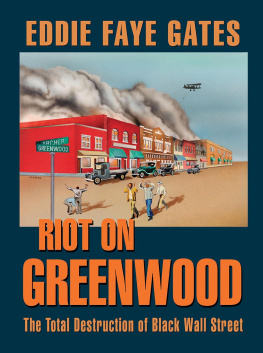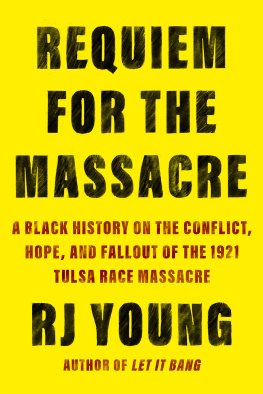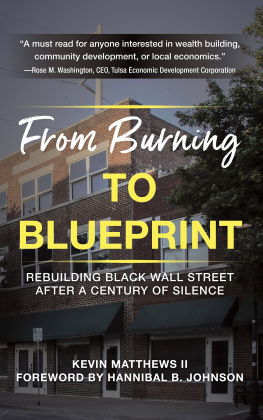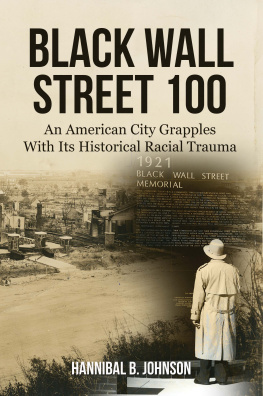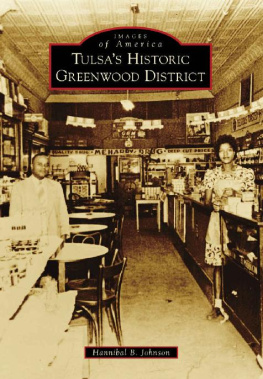
Published by The History Press
Charleston, SC 29403
www.historypress.net
Copyright 2014 by Steve Gerkin
All rights reserved
First published 2014
e-book edition 2014
ISBN 978.1.62585.117.8
Library of Congress Cataloging-in-Publication Data
Gerkin, Steve.
Hidden history of Tulsa / Steve Gerkin.
pages cm.
Includes bibliographical references.
print edition ISBN 978-1-62619-579-0
1. Tulsa (Okla.)--History. 2. Tulsa (Okla.)--Biography. I. Title.
F704.T92G47 2014
976.686--dc23
2014017144
Notice: The information in this book is true and complete to the best of our knowledge. It is offered without guarantee on the part of the author or The History Press. The author and The History Press disclaim all liability in connection with the use of this book.
All rights reserved. No part of this book may be reproduced or transmitted in any form whatsoever without prior written permission from the publisher except in the case of brief quotations embodied in critical articles and reviews.
This first book is dedicated to my wife, Suemy true love, a lady who loves me back.
CONTENTS
This compilation of Steve Gerkins evocative stories is some of the best writing I have read in a very long time. Each one is a gem and when strung together the reader will find an exquisite literary necklace.
Michael Wallis
author, historian, human geographer
In Hidden History of Tulsa, Steve Gerkin does a masterful job of reclaiming some of the citys most remarkable stories and preserving them for a new generation of Oklahomans. Together, these tales of injustice and triumph, opportunism and creativity, give us a broader, deeper understanding of who we are, not just as a community but also as citizens of a complex yet wondrous world.
Teresa Miller, executive director
Oklahoma Center for Poets and Writers
Oklahoma State UniversityTulsa
History presents a correlation between our lives today and those who have gone before us. Gerkins stories prompt us to explore some of Tulsas tales of tragedy and triumph as well as calamity and recovery. We must ask ourselves the following: How did this happen? Could it happen again? How far have we come?
S. Michelle Place, executive director
Tulsa Historical Society
Tulsa has a rich historysome great and some not so greatbut there is much that can be gleaned from stories that may not make the history books. Dr. Gerkin has created a very readable work that brings to life, through stories most people never knew, that part of our history, which might otherwise be lost.
Howard G. Barnett, Jr., president
Oklahoma State UniversityTulsa
This well-written and informative book about Tulsas hidden history reveals the not-so-well-known people, places and events that shaped the history of this great community. In this entertaining tome, you will discover many interesting and some heartbreaking stories about Tulsa.
Beth Freeman, director
Oklahoma State UniversityTulsa Library and Archives
PROLOGUE
Built along the Arkansas River, the late-1800s cow town of Tulsa became the worlds biggest oil slick. Rowdies, roughnecks and renegades descended on the overnight oil industry. For decades, Tulsa was touted as the Oil Capital of the World. These and other known historical events about Tulsey Town have been above ground for years. Yet there are also hidden, historical nuggets right below the surface.
Colorful personalities, racial chaos and criminals, both white collar and blue, dotted the developing landscape. Shrouded by the glitter and wealth generated from the oil industry and the coming of Oral Roberts to south Tulsa, the forgotten history of Tulsa went underground.
Tragedies and triumphs colorize the fabric of any community. Tulsa has had an abundance of fascinating folk who provided a human infrastructure of intrigue, glory and mayhem.
The Ku Klux Klan dominated the political and legal venues in the 1910s and 20s. It influenced elections, verdicts and racial tensions. Blacks migrating from southern slavery states and black freedmen from Oklahoma tribes organized a highly developed black community on the north side of the downtown tracks. Named Greenwood, this settlement earned the title of Black Wall Street. The race riot of 1921 is no secretat least, not any more. Exposed on these pages are the hidden truths and the horrors of several of the massacres victims.
Outrageous professional wrestlers took center stage at the downtown entertainment emporium known as the Avey Coliseum. Clowns and Hollywood entertainers graced the stage along Sixth Street, a street also known as Cedar Street, Tulsas proudest thoroughfare for decades that is born again in todays Pearl District.
Trolleys transported Tulsans to the Coliseum, fairgrounds and the Cains Ballroom to hear the likes of western swing rivals Bob Wills and the murderous maestro Spade Cooley, whose oversized pictures look down on the ballroom floor.
The exposure of the veiled episodes of Tulsa, set free from seclusion, provides an evocative and enjoyable voyage through its hidden history.
ACKNOWLEDGEMENTS
The journey to write historical pieces about the Tulsa area became an eye-opening adventure. Many people deserve hearty thanks.
With one exception, the essays in this book appeared in This Land magazine, found at thislandpress.com. This Land offered a cub reporter a chance to be published. As a contributing editor for This Land, I am especially grateful for the editorial marshaling of This Land founder and editor Michael Mason and Mark Brown, as well as, Vince Lovoi, publisher.
Literary inspiration lies with my good friend, author and human geographer Michael Wallis, who encourages me to search for tantalizing tales and spin songdog stories.
Exhaustive research is key to historical writing. Without the talented Sheri Perkins of the Tulsa Public Library, many of these stories would be lacking.
Images on these pages are, generally, from olden times and require a team of photo gurus like Marc Carlson of the Tulsa Universitys Special Collections and University Archives, Ian Swart of the Tulsa Historical Society and Kathryn Red Corn of the Osage Tribal Museum.
Debbie Neece, Lynn Watts, Beth Freeman and Carol Fillmore were instrumental in providing and improving critical images, as were the Rudisill Regional Library and the Booker T. Washington High School Library. Jim and Chad Rodgers opened the doors of Tulsas Cains Ballroom so that I could capture Spade Cooley on film.
Most of my articles are about people long gone. Yet a few are still vertical and were real champions to tolerate my questions and taunts. Major thanks go to the precious Perlie Moreland, the inimitable J.J. Conley, the resilient K. Rahall, hay artisan Kelly Cox and bad boy turned preacher Johnny Lee Clary.
Thanks, too, for the gracious comments of Michael Wallis, Teresa Miller, Howard Barnett, Beth Freeman and Michelle Place.
Lastly, I salute the Iowa Public School System for giving me a good grammar background.
Part I
EARLY RACIAL TENSIONS:
TULSA RACE RIOT OF 1921 AND THE PRESENCE OF WHITE SUPREMACISTS
Part II
DIRIGIBLE FLYOVER:
ZEPPELIN CIRCLES DOWNTOWN TULSA
Part III
COLORFUL PERSONALITIES:
NATIVE GIANTS AND A HAMBURGER NAZI
Part IV
LANDMARKS AND GANGSTERS:
STREETS, HILLS AND A MURDEROUS MAESTRO
Chapter 1
BENO HALL
Tulsas Den of Terror
Next page

